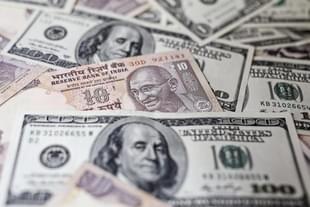Economy
At Rs 68-70 To US Dollar, Rupee Slide Is A Much-Needed Correction, Not A Cause For Panic
R Jagannathan
May 24, 2018, 11:19 AM | Updated 11:19 AM IST
Save & read from anywhere!
Bookmark stories for easy access on any device or the Swarajya app.


The fall in the value of Indian rupee against the US dollar, thanks to the global spike in oil prices, and internal jitters over political instability and fiscal populism ahead of the general elections in 2019, is causing concern on at least three fronts: the probability of higher fiscal and current account deficits (the so-called twin deficits) and imported inflation.
Yes, the big threat is a reigniting of inflation due to rising food and fuel prices, which could negate one of the biggest achievements of the National Democratic Alliance (NDA) government led by Narendra Modi.
However, if we were to take a longer-term view of where the rupee-dollar rate is heading, we can see that this is nothing more than a correction after a period of relatively stable exchange rates from 2013 to last year.
Exchange rates are a function, among other things, of relative inflation rates, net capital inflows into domestic stocks and bonds, including foreign direct investment, and the size and scale of the fiscal and current account deficits.
None of these factors is actually way out of line as of now. The current account deficit (CAD) could be in the range of 2-2.5 per cent of gross domestic product (GDP) this year, and the oil bill could be $25-50 billion higher, but this is nothing to worry about when forex reserves are at $417 billion.
Retail inflation is at 4.58 per cent, well below the outer tolerance limit of 6 per cent which the Reserve Bank of India (RBI) is mandated to treat as the medium-term ceiling.
The fiscal deficit this year is projected at 3.3 per cent, and even if there is some slippage – which is not guaranteed if tax receipts stay buoyant and the goods and services tax starts delivering higher revenues later this year as compliance improves – it is not a cause for much breast-beating.
As against this, consider how the rupee has fared in the last four years during the Modi administration, and how it did in 2010-14 – when economic management had deteriorated under former finance minister Pranab Mukherjee.
Between April-May 2010 and May 2014, the rupee depreciated from around Rs 44 to the US dollar to Rs 58, while in the subsequent four years it depreciated from Rs 58 to Rs 68 (now). In the United Progressive Alliance (UPA) period, the rupee depreciated 32 per cent while in the last four years, it depreciated by just over half that magnitude – that is, even after the recent tumble in the rupee.
Let us be clear: given inflation differentials between India and its major trading partners, a four-five per cent annual rupee depreciation is normal, though this does not happen evenly every year. The rupee stays flat for years on end, and then abruptly corrects when danger signals appear.
What was abnormal was the average 8 per cent depreciation during the last four years of the UPA, which was largely the result of poor inflation management.
This is not to suggest that there is no cause for worry or concern on the rupee’s exchange rate. There is, and a lot will depend on how the finance minister manages the macroeconomy between now and May 2019. If the management is reasonably good, especially the passing on of oil price increases to consumers, a range of Rs 68-70 could be the new normal and entirely reasonable from a medium-term perspective. This will allow exporters to push up shipments and help slow down the deterioration in the CAD.
We should worry only if the rupee slides dramatically below Rs 70, and that too very quickly.
If that happens, the RBI can easily start its dollar sales and also open a special window for crude oil importers, so that this additional demand for dollars does not skew the market exchange rate.
As things stand, there is no case for panic on the rupee-dollar rate. It is actually correcting after a long hiatus. A four-five per cent annual depreciation of the rupee is not something to lose sleep over. We have been like that only.
Jagannathan is former Editorial Director, Swarajya. He tweets at @TheJaggi.




